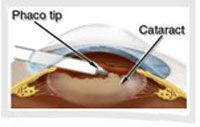What Should One Expect After Cataract Surgery?

Following cataract surgery, patients can expect a quick return to good vision. Thanks to modern technology and advanced surgical techniques, cataract surgery is one of the most successful surgical procedures performed around the world. The statistics speak for themselves. Over 97% of patients claim a return to reliably good vision.{{more}} A lot of patients will still have to wear glasses following surgery. These glasses will mostly be used for reading and other activities.
Even though good vision usually returns quickly, the eye requires several weeks to heal completely. Depending on the type of surgery, most patients may be able to return to their normal activities the day after surgery. The biggest benefit of cataract surgery is that one can return to an active lifestyle in a relatively short space of time.
No stitch/small incision surgical techniques are modern techniques used to restore vision loss. Ultrasound technology (phacoemulsification) is used to remove the cataract. This is the â Laserâ often spoken about by laymen. In actual fact, the â Lasersâ used (unlike those used for Lasik or Diabetic eye disease or in Glaucoma) are really ultrasound waves. In phacoemulsification, or phaco for short, a small probe is inserted into the capsular membrane that surrounds the cloudy lens.
The probe emits ultrasound waves which gently break up the lens into tiny fragments that can then be removed through the tip of the probe. Traditional techniques used to require that the lens be removed in one piece through a large incision that is about one third of the circumference of the cornea. This type of incision usually requires up to about eight stitches. In contrast, the phaco technique allows the lens to be removed through a self-sealing incision that is about 1/6 of an inch wide. Sometimes just one stitch may be needed if the wound is not self-sealing enough.
Some advantages of no stitch/small incision surgery include
* Quicker recovery
* Quicker return to normal activity
* Better vision in a matter of days instead of weeks
* Return home within hours of the procedure
* Reduce the possibility of ruptured sutures
* Less chance of leakage
* Risk of complications reduced
Next week, we will discuss even more modern methods of cataract removal, including topical or no needle anesthesia, no patch surgery, foldable and multi-focal lens implants, among other things.
The loss of sight from cataracts is mostly preventable. Modern technology allows for the quick removal of cataracts and the restoration of good vision. If you happen to be experiencing symptoms of cataracts or other problems in your vision, you should obtain a complete eye examination.
Dr Kenneth Onu is a resident Consultant Ophthalmologist at the Beachmont Eye Institute/Eyes R Us Send questions to: Beachmont@gmail.com
Tel: 784 456-1210









